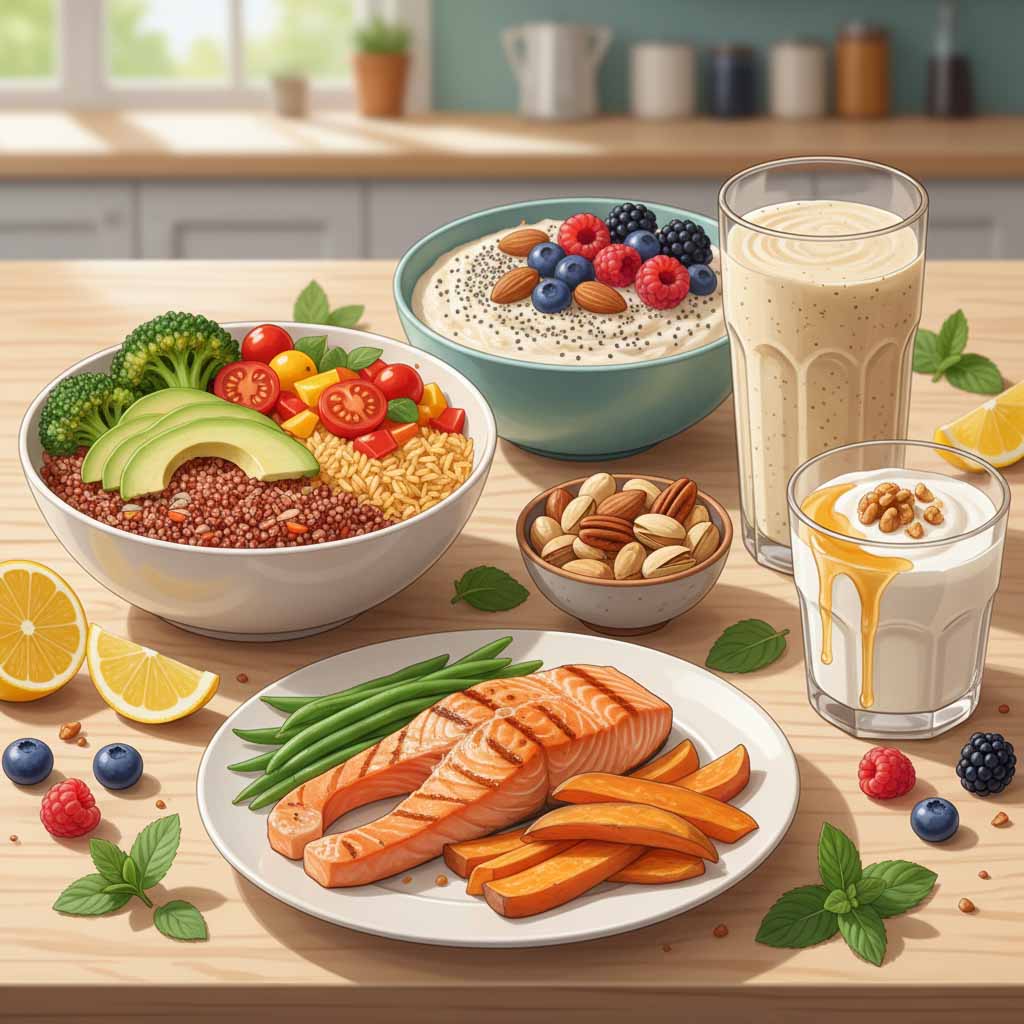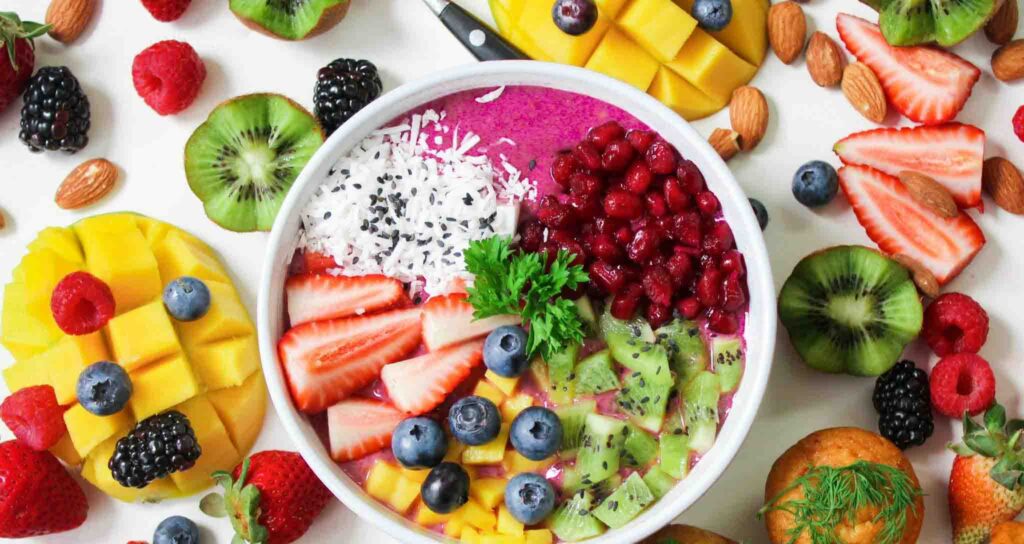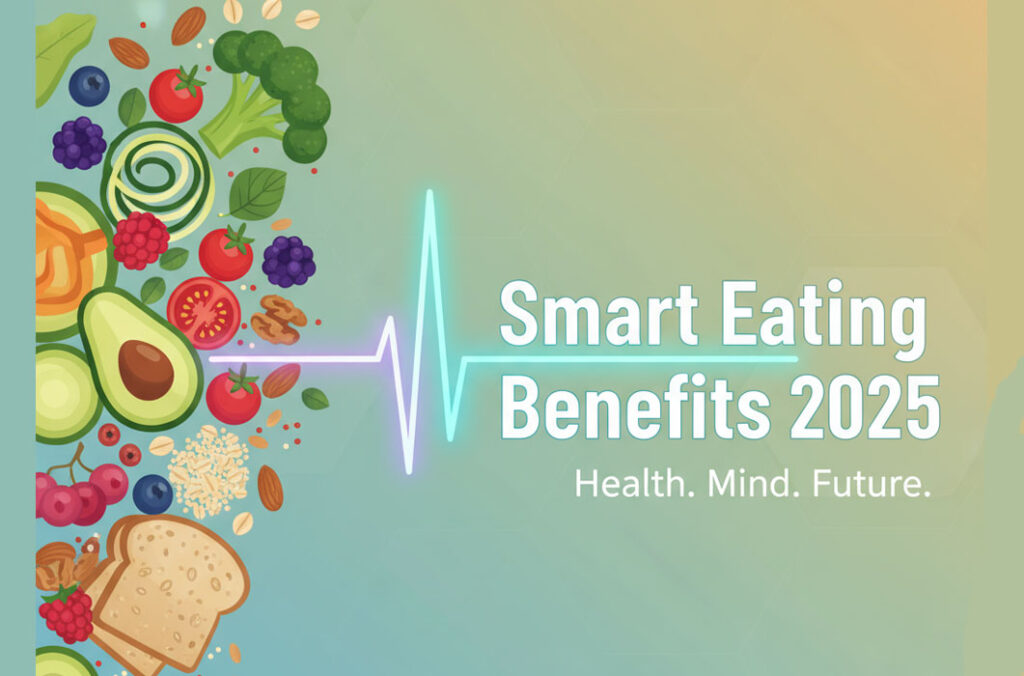It’s 8:30 in the evening, and the supermarket checkout line is buzzing with tired faces. One person grabs instant noodles, another tosses in a packet of cookies, while the woman ahead stares at the shelf of ready-to-eat meals, debating if she should pick the “low-fat” option or just the one that looks tasty. In moments like these, food becomes less about health and more about convenience — and that’s where most of us stumble.
This is exactly where the idea of Smart Eating steps in. Simply put, Smart Eating means choosing foods based on nutrient quality, the right timing, how processed they are, and your personal health needs — not just counting calories. It’s about looking at food as fuel for both body and mind, not just something to fill your plate.
In this blog, we’ll dive into why Smart Eating matters more than ever in 2025, the science-backed benefits you can expect, and how you can build a simple daily and weekly routine that actually fits your lifestyle. You’ll also discover 10 quick swaps to make your meals healthier without losing flavor or time, plus a dedicated FAQ section where we clear up the most common doubts people have about Smart Eating.
By the end, you’ll not only understand the concept but also have practical steps you can start using the very next time you find yourself standing in that checkout line.
What is Smart Eating?
At its core, Smart Eating is the practice of making food choices that go beyond calorie counts. According to the World Health Organization, healthy eating means balancing variety, nutrient density, and moderation — and Smart Eating builds on this by focusing on what you eat, when you eat, and how it suits your unique lifestyle and health needs. It’s not a strict diet but a flexible approach designed to keep your body fueled, your energy steady, and your long-term health protected.
Key Principles of Smart Eating:
- Quality over quantity: Fill your plate with whole foods — fruits, vegetables, lean proteins, and fiber-rich grains. Nutrient density matters more than portion size. (American Heart Association)
- Cut back on ultra-processed foods: Limit packaged snacks, sugary drinks, and meals with long ingredient lists. Studies in the BMJ show strong links between high ultra-processed food intake and chronic diseases.
- Mind the timing and consistency: Eating in line with your body’s natural rhythm — like having balanced meals earlier in the day and avoiding heavy late-night snacks — can improve energy and metabolism. (Health.com)
- Personalize your plate: Age, activity level, and health goals all shape your needs. In 2025, nutrition science emphasizes “need states,” meaning your diet should adapt to your current stage of life and personal health.
Smart Eating isn’t about perfection. It’s about building small, steady habits that make eating simpler, healthier, and more sustainable.
Why Smart Eating Matters in 2025 🌍
We live in a time when food is more available than ever — yet more people are struggling with the effects of poor diets. Ultra-processed foods now make up a growing share of daily calories worldwide, and both child and adult obesity rates continue to climb. UNICEF reports rising concerns about children’s dependence on packaged snacks and sugary drinks, while the CDC warns that diet-related diseases like type 2 diabetes are affecting people at younger ages. Research published in the BMJ adds that higher intake of ultra-processed foods is strongly linked to heart disease and premature death. In short: the convenience-driven food system is costing us long-term health.
This is where Smart Eating becomes essential. By focusing on nutrient quality, food processing levels, and timing, you can protect yourself against today’s biggest health threats. Evidence shows that Smart Eating can deliver powerful benefits:
- Better heart and metabolic health: Studies on adults show improved cholesterol levels, lower blood pressure, and better blood sugar control when diets are rich in whole foods and low in processed items. (PubMed)
- Lower long-term mortality risk: Large-scale analyses confirm that people who reduce ultra-processed food consumption have a significantly lower risk of early death. (PMC)
- Sharper mood and cognition: A fiber- and polyphenol-rich diet feeds the gut microbiome, which in turn supports better mental well-being and brain function. (Kerry Health and Nutrition Institute)
- Longevity and healthy ageing: Nutrients like flavonoids, fiber, and well-timed protein intake are now linked to reduced inflammation and improved ageing markers. (Health.com)
Smart Eating isn’t about chasing fads — it’s about making steady, evidence-based choices that protect your health in the face of modern risks.
Top 10 Science-Backed Benefits of Smart Eating ✅
- Reduces cardiometabolic risk
Research published in the BMJ shows that diets built around whole foods and reduced processed intake significantly lower blood pressure, LDL cholesterol, and type 2 diabetes risk. These changes protect the heart and keep circulation healthy over the long run. - Lowers exposure to harmful additives
Ultra-processed foods often contain preservatives, emulsifiers, and added sugars linked to inflammation and chronic illness. Studies in PMC highlight that people who cut back on these foods experience fewer long-term health complications. - Supports healthy weight management
The CDC notes that balanced eating patterns rich in fiber, protein, and whole grains help regulate appetite and prevent unhealthy weight gain. Unlike crash diets, Smart Eating builds sustainable habits you can maintain for years. - Improves gut health and mood
According to the Kerry Health and Nutrition Institute, fiber and polyphenol-rich foods feed beneficial gut bacteria. A healthy gut microbiome supports not just digestion but also mood stability and sharper mental clarity. - Boosts energy and sleep quality
Health.com reports that eating at consistent times, with balanced meals earlier in the day, improves daytime energy and nighttime sleep. Smart Eating aligns your body with its natural rhythm, reducing fatigue. - Reduces chronic inflammation
A diet centered on colorful vegetables, fruits, nuts, and omega-3 fats lowers inflammatory markers in the body. This helps protect against conditions like arthritis, cardiovascular disease, and metabolic disorders. (PubMed) - Increases nutrient density
Smart Eating naturally raises your intake of vitamins, minerals, and antioxidants. Studies show this helps close nutrient gaps common in populations relying heavily on packaged foods. (BMJ) - Builds metabolic flexibility
Balanced meals that combine protein, healthy fats, and fiber train your body to shift smoothly between burning carbs and fats. Over time, this reduces blood sugar spikes and crashes. (PMC) - Saves money through smart swaps
Cooking with seasonal produce, legumes, and whole grains often costs less than relying on convenience foods. Families who adopt Smart Eating frequently report both health and budget improvements. (CDC) - Supports longevity and healthy ageing
Nutrients like flavonoids, fiber, and quality protein have been linked to reduced oxidative stress and slower age-related decline. Smart Eating lays the foundation for a longer, healthier life. (Health.com)
Principles to Follow — Practical Rules of Smart Eating 🧾

Smart Eating isn’t about perfection or restriction; it’s about small choices that add up. Here are five simple rules you can start applying to your meals right away:
Rule 1: Fill 50–70% of your plate with whole foods
Think of your plate as a circle. At least half should be colorful vegetables and fruits, with room for lean proteins and whole grains. The American Heart Association recommends keeping ultra-processed items as the smallest slice of the pie.
Rule 2: Prioritize fiber and protein at every meal
The Dietary Guidelines highlight fiber and protein as the two nutrients most people don’t get enough of. Start your day with oatmeal plus nuts, or add beans to your salad — these combos keep you full and balance blood sugar.
Rule 3: Limit sugary drinks — choose water or tea instead
The World Health Organization advises cutting back on sugar-sweetened beverages, one of the biggest sources of “hidden” calories. Swap soda for sparkling water with lemon or choose unsweetened green tea for an energy lift.
Rule 4: Swap out three common ultra-processed foods
Instead of flavored yogurt cups, go for plain yogurt topped with fresh fruit. Replace packaged chips with roasted chickpeas. Trade sugary breakfast cereal for homemade muesli with oats and seeds. Studies in the BMJ show even small swaps reduce long-term risk.
Rule 5: Use quick label checks for packaged foods
If the ingredient list runs longer than your phone screen, it’s a red flag. A good shortcut: look for less than 10 grams of sugar per 100 grams and simple ingredients you can pronounce. This habit makes shopping smarter without extra effort.
Daily & Weekly Smart Eating Routine 📅
Eating smarter doesn’t mean reinventing your kitchen every day. It’s about having a routine you can repeat without stress. Here’s a simple 7-day micro-plan to guide your mornings, lunches, snacks, dinners, and weekend prep.
Morning: Start with protein + fiber
Health experts agree that a high-protein, fiber-packed breakfast helps stabilize energy. Instead of skipping breakfast or grabbing a sugary pastry, try:
- Oatmeal topped with chia seeds, almonds, and berries.
- Scrambled eggs with spinach and whole-grain toast.
- A smoothie made with unsweetened yogurt, banana, and flaxseed.
These meals keep blood sugar steady and prevent mid-morning crashes. (Health.com)
Lunch: Build-your-bowl method
Think of lunch as a bowl with four layers — whole grain + vegetables + lean protein + healthy fat. For example:
- Brown rice + roasted broccoli + grilled chicken + avocado slices.
- Quinoa + cucumber & tomato + chickpeas + olive oil drizzle.
This flexible “mix-and-match” method makes it easy to build balanced meals without overthinking. (American Heart Association)
Snacks: Keep it simple and nutrient-rich
Smart Eating snacks should be light, portable, and satisfying. Great options include:
- A handful of unsalted nuts (about 20–25 almonds).
- A small bowl of plain yogurt with a teaspoon of honey.
- One fresh fruit, like an apple or banana.
These choices give you protein, healthy fats, and natural sugars without the crash that comes from packaged snacks. (The Times of India)
Dinner: Earlier and lighter for better rest
Dinner doesn’t need to be heavy. Eating a little earlier and choosing lighter carbs helps if you’re sensitive to late-night glucose spikes. Try:
- Grilled salmon with steamed green beans and a small sweet potato.
- Lentil soup with a side salad.
- Stir-fried tofu with mixed vegetables and a small portion of brown rice.
Aim to finish dinner at least two hours before bedtime for better sleep quality. (Health.com)
Weekend batch-cook & shopping list
Set aside an hour on the weekend to prep basics that save time during the week:
- Cook a large batch of quinoa or brown rice.
- Roast a tray of mixed vegetables (carrots, zucchini, peppers).
- Prepare boiled eggs and wash fresh greens.
10-item smart shopping list: Oats, quinoa, brown rice, spinach, broccoli, chickpeas, plain yogurt, eggs, nuts, seasonal fruits.
With these, you can mix and match dozens of quick, healthy meals without stress.

Common Myths About Smart Eating — Debunked ❌
Smart Eating is simple at its core, yet misinformation often clouds the basics. Let’s clear up a few persistent myths with science-backed clarity.
Myth 1: “All fats are bad.”
Not true — healthy fats (like olive oil, nuts, and fatty fish) are essential for brain and heart health. (Dietary Guidelines for Americans)
Myth 2: “You must avoid carbs.”
The problem isn’t carbs but refined carbs. Whole-grain carbs with fiber are linked to better digestion and long-term energy. (Dietary Guidelines for Americans)
Myth 3: “Skipping meals speeds up weight loss.”
Skipping meals often backfires, leading to overeating later and unstable blood sugar. Consistent, balanced meals work better. (CDC)
Myth 4: “Protein is only for athletes.”
Everyone needs protein to support muscle, immunity, and repair. Even sedentary adults benefit from 20–30g protein per meal. (Harvard Health)
Myth 5: “Healthy food is always expensive.”
Staples like beans, oats, eggs, and seasonal vegetables are cost-effective nutrient powerhouses. Smart swaps save money. (FAO/WHO)
Myth 6: “Snacking is unhealthy.”
Processed snacks can be harmful, but whole-food snacks like nuts or yogurt can improve satiety and nutrient intake. (The Times of India)
Myth 7: “Ultra-processed foods in moderation are harmless.”
Even moderate intake is linked to higher risks of obesity and heart disease — minimizing them matters. (BMJ, 2023)
FAQs on Smart Eating ❓
1. What does Smart Eating mean?
Smart Eating means choosing foods for nutrient quality, timing, and personal needs instead of just focusing on calories. It’s about building meals around whole foods, balance, and sustainable habits. This approach adapts to your lifestyle while improving long-term health. (World Health Organization)
2. Is smart eating the same as dieting?
Not at all. Dieting usually restricts certain foods or entire groups, which can feel temporary and frustrating. Smart Eating is about creating flexible, long-term habits like balancing portions, prioritizing fiber and protein, and making sustainable food swaps. (CDC)
3. Can smart eating help with weight loss?
Yes — Smart Eating supports natural weight management by stabilizing blood sugar, reducing cravings, and keeping you fuller for longer. Unlike crash diets, it encourages steady progress without harming metabolism. (BMJ)
4. Are ultra-processed foods always harmful?
Research shows even moderate consumption of ultra-processed foods is linked to obesity, heart disease, and higher mortality risk. While an occasional treat won’t harm you, consistently limiting these foods makes a major difference to overall health. (BMJ, 2023)
5. How do I start smart eating with a tight budget?
You don’t need expensive superfoods. Start with affordable staples like beans, eggs, oats, frozen vegetables, and seasonal produce. Batch cooking simple recipes and making a short shopping list help save money and reduce waste. (FAO/WHO)
6. Can smart eating improve mental health?
Yes — a diet rich in fiber, omega-3 fatty acids, and polyphenols supports gut health, which is closely linked to brain function and mood. Studies show people following nutrient-rich diets report lower stress and better concentration. (Kerry Health & Nutrition Institute)
7. Is intermittent fasting part of smart eating?
It can be, depending on your needs. Some people benefit from eating within a set time window (like 10 a.m.–6 p.m.), while others focus on balanced meals spread throughout the day. The core of Smart Eating remains food quality and consistency. (Harvard Health)
8. How to track progress without an app?
You don’t need high-tech tools. Keep a simple food journal, take note of how meals affect your energy, and use easy visuals like the “half plate veggies” rule. Improvements in sleep, mood, and digestion are also reliable signs of progress. (Dietary Guidelines for Americans)
Final Thought 🌱
Smart Eating isn’t about strict rules or short-term diets — it’s about learning to listen to your body and making food choices that actually work for your health, lifestyle, and goals. In 2025, when ultra-processed foods and quick fixes surround us, choosing smarter isn’t just a trend — it’s a survival skill for long-term wellness.
By focusing on nutrient-rich whole foods, balancing fiber and protein, timing your meals wisely, and staying consistent, you build habits that pay off in energy, mood, and longevity. And the best part? Smart Eating adapts to you — your culture, budget, and daily routine.
Start small: swap one processed snack for fruit and yogurt, add an extra handful of vegetables to your plate, or prep a simple meal ahead of time. These little shifts compound over weeks and months into a healthier, more resilient version of yourself.
Remember: every bite is a choice — and every smart choice is a step toward a stronger future. 🌍💪
Sources (key references with links)
| # | Reference | Link |
|---|---|---|
| 1 | WHO — Healthy Diet (fact sheet) | WHO “Healthy diet” Fact Sheet World Health Organization |
| 2 | BMJ — Systematic evidence on ultra-processed foods and adverse outcomes (2024) | BMJ: Ultra-processed food exposure and adverse health outcomes BMJ |
| 3 | CDC — Trends in ultra-processed food consumption & caloric intake (2025) | CDC Data Brief No. 536: Ultra-processed food consumption in youth and adults (US, 2021-2023) CDC Stacks |
| 4 | PMC — Meta-analyses & cohort studies on UPFs & mortality | “Ultra-processed foods and human health: An umbrella review” (PMC) ScienceDirect |
| 5 | JM Vitale et al. — UPF consumption & metabolic disease risks | PMC article: Ultra-Processed Foods and Human Health (Vitale, 2023) PMC |
| 6 | UNICEF & reports on childhood obesity linked to ultra-processed foods | Food & Wine: UNICEF report on Ultra-processed Foods & Childhood Obesity Food & Wine |
| 7 | Heart Org — Practical eat smart guidance / “How to eat better” fact sheet | American Heart Association: How to Eat Better Fact Sheet heart.org |
CTA
✨ Stay inspired & connect with bright minds
👉 E-Vichar on Facebook
💡 Unlock secrets for scalp, skin & hair health
👉 Scalp Microbiome Guide
🤖 Discover the top free chatbots of 2025
👉 Best Free Chatbots Guide




